Los Glaciers National ParkFounded in 1937, the name of Los Glaciers
National Park is derived from the presence
of numerous glaciers originating in the great
field of Patagonian Ice, the biggest layer
of ice after Antarctica. Recognized as a
World Heritage Site in 1981, Los Glaciers
National Park is truly beautiful. The park
is 8,500 square miles, half of which is covered
by ice fields that connect over 45 major
glaciers. It features the beautiful mount
Fitz Roy and two of Argentina's largest
lakes (Lago Argentino - the largest lake
in Argentina and Lake Viedma) both lakes
feeding into the Santa Cruz River, which
drains directly into the neighbouring Atlantic
Ocean.
Seeing the glaciers is one of the most dazzling
experiences. Maybe because they are millions
of years old, maybe because of the various
shades of blue that they acquire when exposed
to sunlight, or maybe simply because their
whimsical shapes and monumental size make
us think of the true beauty of nature. Whatever
the reason, thousands of people from all
round the world spend considerable amounts
of money in order to appreciate them.
Amid nature's constructions, one mustn't
overlook the bird and wild life. Perhaps
unique in the world, around Lake Argentina
can be seen wild cattle and horses. The cattle
went wild after they had been abandoned by
the settlers when the National Park Los Glaciares
was created. Apparently, the cattle can be
dangerous. The forests around the lake are
also home to the rarely seen pumas.
The Perito Moreno Glacier
Imagine a fifteen-story tall wall of ice
looming over a backdrop of snow-capped mountain
peaks, and you'll begin to understand
the majesty that is the Perito Moreno Glacier.
This glacier, which is one of the largest
in the region, is also the most scientifically
significant in that it’s still growing
in size every day. You can hear the crackles
and creaks and gasp as the front wall of
the glacier falls away in front of you.
Situated 80km (50miles) from El Calafate,
Perito Moreno is an enormous glacier (30-60m
high x 30km/19 miles x 4km wide with 14Km
in sight). It is a stable glacier that has
not changed its dimensions in over 100 years.
It moves at 1.5 to 2 metres a day and sheds
ice at its front wall every day as its front
point crashes into the land.
Some years this 18-mile long river of ice
advances across Lake Argentina, splitting
it in two and creating a natural dam. Eventually
water behind the glacier rises and, seeking
equilibrium tunnels beneath the glacier.
Slowly, the warmer lake waters carve a giant
hole through the glacier, leaving only a
narrow ice bridge across the top. When the
bridge becomes unstable giant chunks of ice
begin to calve from the glacier. Towering
plumes of water and mist explode from the
lake whenever these mini icebergs plunge
into the lake, 200 feet below.
Prior to 2004, the bridge had not collapsed
for 16 years. Since then, this finger of
the glacier has advanced and collapsed three
times: in the summer of 2004 and again in
the summer of 2006. The most recent occurrence
was in the winter of 2008, the first time
the bridge has ever fallen during the colder
winter months. Some attribute this to global
warming, although unlike many glaciers around
the world, Perito Moreno is not retreating.
In 1988, the ice blocked the channel between
the two lakes with the southern lake rising
by 22m but when it finally broke through
the southern lake emptied into the northern
lake in a day.
There are many viewing platforms and easy
trails (with quite a number of steps) to
make the visit and the observation easy and
pleasant. You can enjoy a trek on the glacier
and take a boat excursion to see this and
many other glaciers and places in the Los
Glacieres National Park. The colours and
shapes of the icebergs floating in the lake
are really awesome, making a boat ride on
a sunny day a fantastic day out.
|
|
|
|
|
|
|
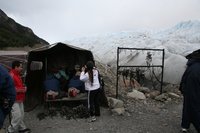 |
| Fitting the crampons |
|
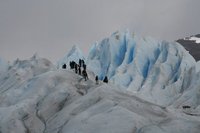 |
| Trekking the glacier |
|
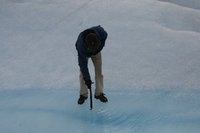 |
| Solid ice |
|
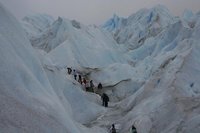 |
| Trekking the glacier |
|
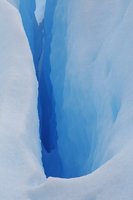 |
| Beautiful blues |
|
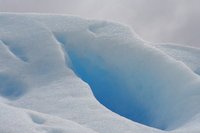 |
| Beautiful blues |
|
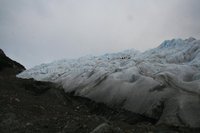 |
| The glacier edge |
|
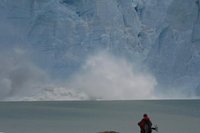 |
| Another chunk falls in |
|
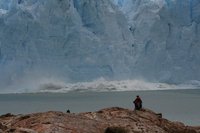 |
| And causes a wave |
|
|
|
|
|
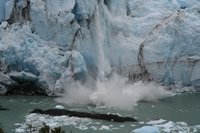 |
| Another chunk falls in |
|
|
|
|
|
|
|
Upsala Glacier
This glacier (60-80m high x 60km/38 miles
x 5-7km wide) can only be reached by boat,
since it is located on the northern side
of Lago Argentino. Its main attraction, besides
its dimension (much larger than the Perito
Moreno glacier), is the size of the blocks
that fall from its front. They are enormous
blocks, generally larger than the boats used
to visit the area. This is probably so because
its front goes deeper than Perito Moreno,
and there is more water flowing under its
base (it is not certain but it is believed
that its front is not sitting on the bed
but floating), so there is less pressure
when moving. It is not common to observe
a glacier rupture, but sailing among its
icebergs is a fascinating experience. During
our visit there had been many large chunks
of fallen ice that had totally blocked the
river leading up to the front wall of the
glacier so we could only sail along the front
wall of the large chunks of ice and view
Upsala Glacier from a distance.
Spegazzini Glacier
The Spegazzini glacier (80-135m high x 25km/16
miles x 1.5km wide) characterizes by being
the highest glacier often visited. It's
also unique because it shows no signs of
receding, a common phenomenon in large glaciers;
on the contrary its front wall seems larger.
The glacier is led by both the Mayo Northe
and Peineta Glaciers and is one of the most
charming ones due to its natural surrounding.
The glacier was named after the botanist
Carlos Spegazzini who made the first studies
of the local flora.
The formation of a Glacier
The formation process of the glacier ice
– a bluish crystalline mass —
is by the accumulation of successive snowfall
that result in the liberation of the air
caused by its mere weight: from the “snow
crystals” that fuse forming more compressed
“granules” which turn into a
dense mass, until it turns into a geoid when
it reaches more transparency and hardness.
The basic conditions are great snowfall and
a mean annual temperature that makes the
conservation of the snow possible.
Icebergs
Icebergs of various shapes and colours are
spread over the Lago Argentina by the action
of wind and water currents. They show only
15% of their actual size above the level
of water "hiding" the other 85%
under it. The bluish colour of the ice is
given by the degree of compression and the
reflected effect of light.